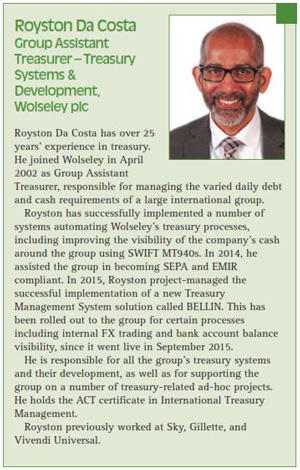by Royston da Costa, Group Assistant Treasurer, Treasury Systems & Development, Wolseley plc
In November 2013 (TMI edition 221) Royston Da Costa published an article in TMI outlining the journey that Wolseley’s treasury has undertaken to enhance both financial and operational efficiency, leveraging a combination of treasury technology and banking solutions. In this edition, he provides an update on the most recent stages of this journey.
Key Points
- Wolseley’s treasury has, since 2006, undergone a radical transformation to enhance its financial and operational efficiency
- In order to improve group liquidity and cash visibility a successful cash pooling programme was implemented in 2010
- Technological solutions such as electronic dealing from MyTreasury and bank connectivity have been harnessed to improve cash visibility further, and RegisTR and BELLIN’s tm5 provide the hub for treasury technology infrastructure
- The article outlines future plans including leasing, commodity hedging and improved cash flow forecasting
The journey’s starting point
Until 2006, treasury activities were managed using a series of spreadsheets, with a large number of labour-intensive processes, such as confirmation transmission and matching, and manual transfer of data to ancillary systems such as the general ledger, consolidation system and electronic banking. In 2006, we made the decision to implement a treasury management system (TMS), which was supplemented in 2008 by automated confirmation matching. We recognised that the TMS was an essential platform to enable us to develop more sophisticated treasury strategies and support the evolving needs of the business more effectively in the future, a view that has since been strongly validated.

Cash visibility and control
As the company has grown in both scale and geographic scope, managing group liquidity and risk has become a more significant challenge. Key to overcoming this was to maximise visibility over cash, which is a highly complex undertaking given that we have around 500 bank accounts with 78 banks, 41 of which are based in the United States. Historically, this involved obtaining balance information from business units by email and collating this centrally on a spreadsheet. A key step in achieving our treasury objectives was the introduction of a global cash pooling programme, which we implemented with Bank Mendes Gans (BMG) in 2010. We had a variety of objectives: in particular, by improving group liquidity, we could leverage cash surpluses across the group to reduce the need for external financing and therefore reduce bank charges. We would also improve cash visibility which would enable us to manage our cash and risk more strategically.
Sign up for free to read the full article
Register Login with LinkedInAlready have an account?
Login
Download our Free Treasury App for mobile and tablet to read articles – no log in required.
Download Version Download Version





























